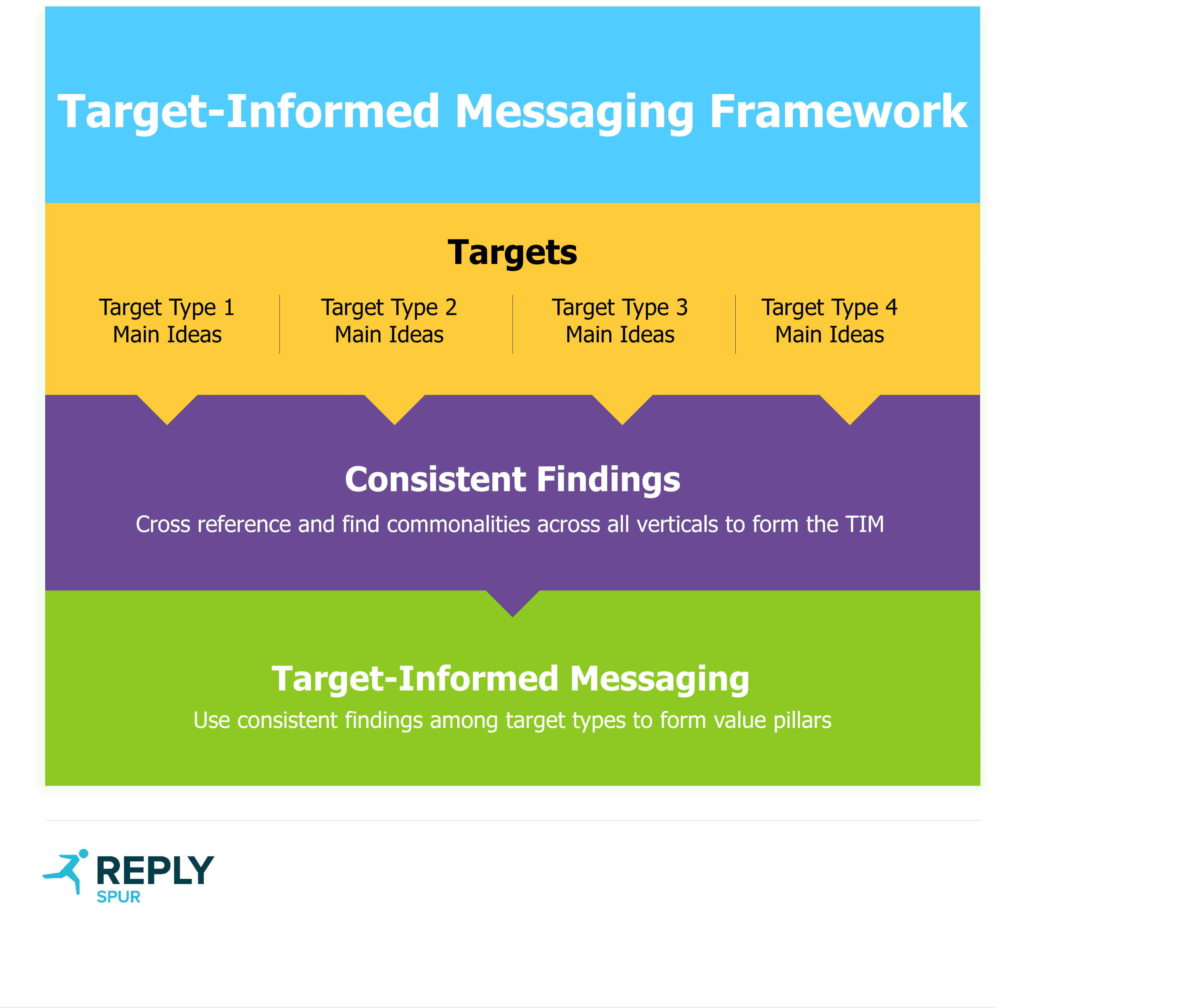Within the marketing and communication space, messaging can take many forms. From general messaging to a broad audience to hyper-targeted content, each type of messaging serves an important purpose.
For instance, one useful framework in marketing is the idea of vertical messaging (specific) versus horizontal messaging (broad). Vertical messaging (also known as audience-specific messaging) refers to content that is created exclusively for one audience, segment, industry, or target. On the other hand, horizontal messaging alludes to broad and generalized content created for a wide range of audience segments or targets unspecific to any industry, region, or category.
Through our work with large technology clients, we’ve developed a third hybrid type called “target-informed messaging (TIM).” TIM is essentially horizontal messaging that is informed by a group of relevant target groups. Combining the concepts of both horizontal and vertical messaging, TIM functions as a broad story made up of the commonalities among all your target categories.
Read on to learn three key tips that will help you get started with creating effective TIM in sales and marketing content.
#1: When you should use target-informed messaging
Target-informed messaging can address a wide variety of business use cases, but they all boil down to this: you’re hoping to sell a product, solution, or program to more than one audience at a time.
As an example, let’s use a technology company offering remote work software. The software appeals to multiple distinct groups — perhaps healthcare and financial services providers — but creating distinct content for each industry is not viable. In such a case, they need horizontal messaging. At the same time, they don’t want a too-broad narrative that could alienate one or more target industries. Looking for the perfect type of messaging is a common conundrum for companies of all sizes and using TIM can help alleviate this issue.
#2: How to create target-informed messaging
Start with researching the value of your solution from a broad, horizontal perspective. Gather insight from team members who have a bird’s-eye view of the solution and your customers.
- What are your core differentiators?
- What does your solution do particularly well?
This first part of the process is nearly identical to a standard messaging creation initiative, but this is the point at which many organizations end the project. Often teams have developed horizontal messaging but have not taken the time to use the target categories to inform the strategy, which can limit the reach and effectiveness of marketing and sales efforts.
After narrowing down some horizontal messages, do some research about each of your target groups — industries, regions, audiences, or other segments.
Topics to include in your research:
- What are the specific pain points for each target?
- What are some typical or priority use cases that the solution addresses? (The list of use cases could potentially be long.)
- Do some concerns warrant a higher priority over others?
- What sets each target’s needs apart from others?
Next, compare and contrast:
- Which key audience and horizontal points overlap?
- Which findings are consistent across groups?
- Which insights are specific to only one or two audiences, but aren’t applicable to the others?
The key points that are consistent across all the groups will form your TIM. Unlike horizontal messaging that hasn’t formally and systematically taken all relevant specific groups into account, TIM messaging is tailored to all relevant groups and key customers.
Of course, your TIM won’t go in-depth into some of the highly specific topics from each group, but that’s okay. Your number one goal is a story that can be told everywhere without losing each target group’s most salient needs — or even worse, directly contradicting one or more groups.
The process is reflected in the framework below.

Once you’re able to say that your messaging tells a cohesive and compelling story across target groups, without alienating any of the groups, you’re ready to use your TIM in marketing and sales content.
#3: How to best use target-informed messaging
Your teams can use your completed TIM in nearly all sales efforts. The target-informed messaging will keep the story consistent for the wide variety of groups reading it — without it feeling overly broad or impersonal.
Let’s go back to the example of a technology company offering remote work software. During the process of creating their TIM, the team discovered that all target groups consider cybersecurity to be top-of-mind.
The marketing team created a blog about the software’s security features that’s based on the TIM and tells a broad story while still appealing to different groups. The blog appeals to customers from any of the technology company’s target industries — broadening its reach and ensuring effectiveness. The sales team could also use the TIM to hold 1-on-1 conversations with customers from their respective industry targets without having to rewrite the messaging, keeping the story of the software’s overall value clear and consistent.
The foundation of TIM messaging that’s informed by all relevant target groups is not so different from what most marketers consider messaging or value pillars — it’s the foundational story you want to tell your customers about your company, solution, or product.
But when you consider each of your target groups to find differences and commonalities among them, you’re able to tell a story capable of greater reach and resonance.
Spur Reply frequently engages with clients to build multiple forms of strategic messaging that take a variety of target audiences into account. Reach out if you think your team could also benefit from our expert guidance.

